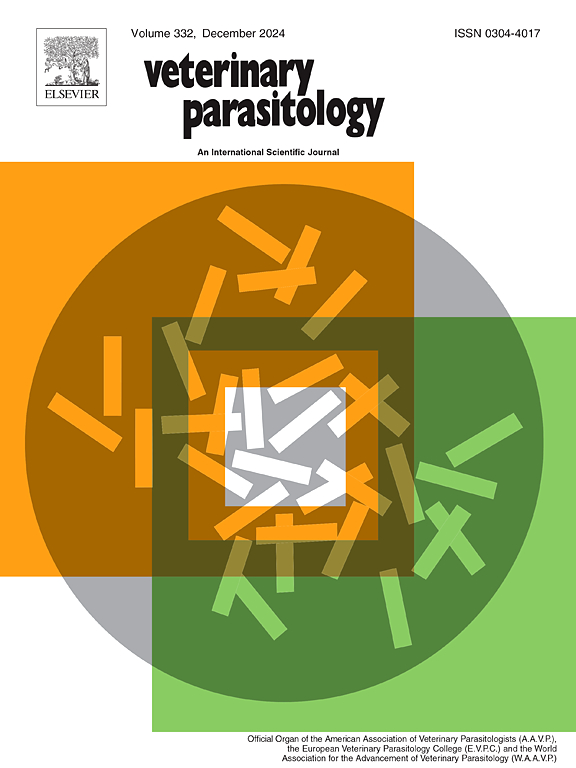Psoroptes ovis mange in sheep: Organ and tissue weights as indicators of the impact on organismal metabolism, lymphatic system and body composition
IF 2
2区 农林科学
Q2 PARASITOLOGY
引用次数: 0
Abstract
Although adverse effects on the welfare, skin pathology and host immune responses of ovine psoroptic mange are well described, there is only limited research on the impact on the performance of the animals and underlying pathogenicity. To provide objective data on effects of the disease at organismal level, weights of organs and tissues of sheep included in a parasiticide study with groups of mange-infested, mange-infested and treated and non-infested animals were evaluated. For the study, 48 young Merino sheep were formed randomly into three equal-sized groups on sex and body weight - to develop mange without intervention (ʽinfestedʼ), to develop mange and treated 10 weeks after initial infestation (ʽinfested-treatedʼ) or to be prevented from mange infestation – and infested twice with Psoroptes ovis mites. Mange developed in all ʽinfestedʼ and ʽinfested-treatedʼ animals and was maintained by the ʽinfestedʼ animals throughout the study while the ʽinfested-treatedʼ animals became mite-negative four weeks after treatment. No mites established on the pre-infestation-treated sheep which served as ʽnon-infestedʼ controls for the analyses. At slaughter 16 weeks after the initial mite infestation, the ʽinfestedʼ animals had significantly (p < 0.05) lower relative (organ/tissue weight divided by live weight) omental fat, perirenal fat and thymus weights and higher relative liver, adrenal glands, prescapular and precrural lymph nodes, gastrointestinal tract, metacarpus bone and skin weights than the ʽnon-infestedʼ animals. They also had significantly lower relative thymus and gastrointestinal tracts weights and higher relative adrenal glands, prescapular lymph nodes, precrural lymph nodes and skin weights than the ʽinfested-treatedʼ animals. The organ/tissue weights of the ʽinfested-treatedʼ animals indicated that many changes observed in the ʽinfestedʼ animals improved substantially within six weeks of treatment. Analysis of the organ weights demonstrates the impact of ovine psoroptic mange on protein and energy metabolism (lower adipose tissues and higher liver and adrenal glands weights as measures of increased demand for maintenance or chronic stress of the mite infestation) and defense mechanisms (lower thymus weight reflecting suppression from increased adrenal activity and higher weight of the peripheral lymph nodes as local reaction to the continuous exposure of antigens originating from the mite-induced exudative dermatitis). In addition, higher gastrointestinal tract plus skin weights and higher metacarpus bone weight leading to lower dressing percentage and higher carcass bone ratio, respectively, reflect the change in body composition and tissue disposition resulting in overall reduction in market value.
绵羊的卵巢丝虫病:器官和组织重量作为对机体代谢、淋巴系统和身体组成影响的指标
虽然对羊体膜病的福利、皮肤病理和宿主免疫反应的不利影响有很好的描述,但对动物生产性能和潜在致病性的影响研究有限。为了提供有关该疾病在机体水平上影响的客观数据,在一项杀虫研究中,对感染、感染、治疗和未感染的几组羊的器官和组织重量进行了评估。在这项研究中,48只年轻的美利奴羊根据性别和体重被随机分成三个大小相等的组——在没有干预的情况下发生管理(被感染),在首次感染10周后发生管理和治疗(被感染治疗)或被阻止管理感染——并被感染两次。在所有被感染和被感染的动物中都出现了螨虫病,并且在整个研究过程中被感染的动物保持了螨虫病,而被感染的动物在治疗后四周变成了螨虫阴性。作为未感染的对照,未在感染前处理的羊身上发现螨虫。初染螨16周屠宰时,染螨动物的网膜脂肪、肾周脂肪和胸腺重量(器官/组织重量除以活重)显著低于(p <; 0.05),肝脏、肾上腺、包膜前和心前淋巴结、胃肠道、跖骨和皮肤重量显著高于未染螨动物。它们的胸腺和胃肠道的相对重量也显著低于虫虫处理的动物,而肾上腺、包膜前淋巴结、脑膜前淋巴结和皮肤的相对重量则显著高于虫虫处理的动物。被感染的动物的器官/组织重量表明,在治疗的六周内,在被感染的动物身上观察到的许多变化有了很大的改善。对器官重量的分析表明,羊淋巴结管理对蛋白质和能量代谢的影响(脂肪组织减少,肝脏和肾上腺重量增加,作为维持或螨虫感染的慢性应激需求增加的措施)和防御机制(胸腺重量降低反映肾上腺活性增加的抑制,周围淋巴结重量增加,作为持续暴露于抗原的局部反应)螨性渗出性皮炎)。此外,较高的胃肠道加皮肤重量和较高的掌骨重量分别导致屠宰率降低和胴体骨率提高,反映了身体组成和组织配置的变化导致市场价值整体下降。
本文章由计算机程序翻译,如有差异,请以英文原文为准。
求助全文
约1分钟内获得全文
求助全文
来源期刊

Veterinary parasitology
农林科学-寄生虫学
CiteScore
5.30
自引率
7.70%
发文量
126
审稿时长
36 days
期刊介绍:
The journal Veterinary Parasitology has an open access mirror journal,Veterinary Parasitology: X, sharing the same aims and scope, editorial team, submission system and rigorous peer review.
This journal is concerned with those aspects of helminthology, protozoology and entomology which are of interest to animal health investigators, veterinary practitioners and others with a special interest in parasitology. Papers of the highest quality dealing with all aspects of disease prevention, pathology, treatment, epidemiology, and control of parasites in all domesticated animals, fall within the scope of the journal. Papers of geographically limited (local) interest which are not of interest to an international audience will not be accepted. Authors who submit papers based on local data will need to indicate why their paper is relevant to a broader readership.
Parasitological studies on laboratory animals fall within the scope of the journal only if they provide a reasonably close model of a disease of domestic animals. Additionally the journal will consider papers relating to wildlife species where they may act as disease reservoirs to domestic animals, or as a zoonotic reservoir. Case studies considered to be unique or of specific interest to the journal, will also be considered on occasions at the Editors'' discretion. Papers dealing exclusively with the taxonomy of parasites do not fall within the scope of the journal.
 求助内容:
求助内容: 应助结果提醒方式:
应助结果提醒方式:


